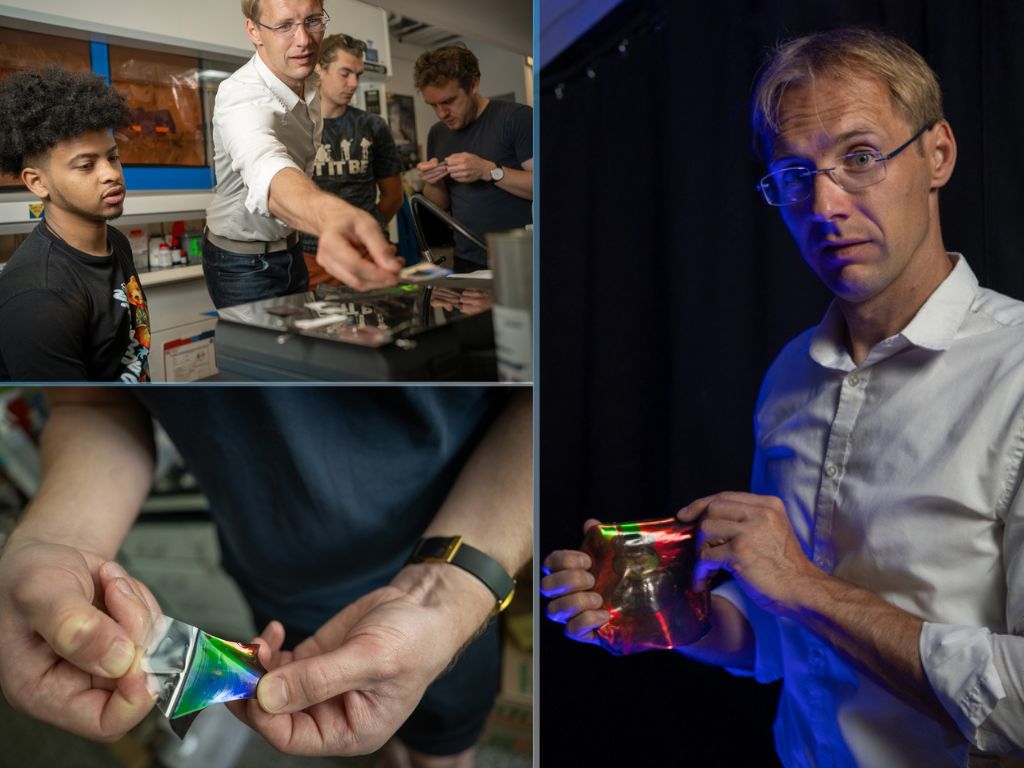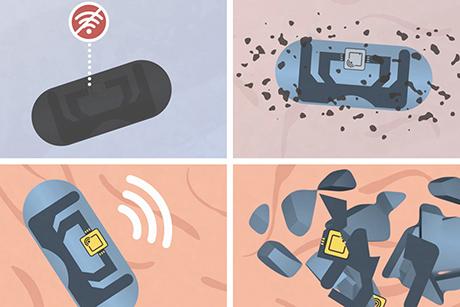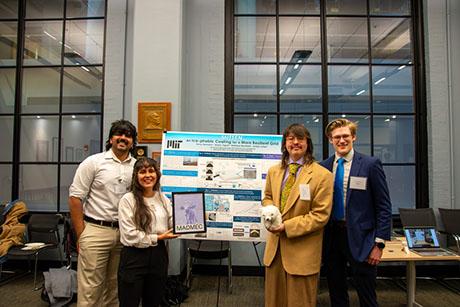Coloring outside the lines
For Mathias Kolle, the wings of a butterfly are a window into a better material world. The insects’ iridescence is a result of “structural color” rather than pigments or dyes: A single wing is layered with hundreds of thousands of microscopic scales that act as tiny reflectors, bouncing light from various angles and depths, to give butterflies their signature color and shimmer.
Kolle, an associate professor of mechanical engineering at MIT, is diving into the microstructure of butterfly wings and other optically interesting organisms in search of ways to replicate, and even improve upon, their structural, light-bending effects. He and his students are designing materials, inspired by nature, that exhibit advanced optical functions, including color-changing sheets and fibers that can be integrated into pressure-monitoring bandages or tied into strength-testing knots, as well as fluid droplets that amplify the rainbow.
Just as butterflies reflect the whole spectrum of colors without any inherent pigments or dyes, Kolle envisions materials such as fabrics, fibers, and fluids that can be engineered to generate colors without chemicals.
“If done right, materials can be intrinsically colored just by their structure, without adding a chemical pigment or dye. In fact, these colors are way more brilliant than what can be achieved with pigments alone,” says Kolle, who recently received tenure. “It’s thrilling to take a peek at the many stunning examples of structural color in nature and ask how we can use knowledge about nature’s ways to play with light to give functionality to materials in novel ways.”
Top Left: Kolle and his students are designing materials, inspired by nature, that exhibit advanced optical functions, such as color-changing fibers that can be woven into pressure-monitoring bandages and tied into strength-testing knots. | Bottom Left: Just as butterflies reflect the whole spectrum of colors without any inherent pigments or dyes, Kolle envisions materials such as fabrics, fibers, and fluids that can be engineered to generate colors without chemicals. | Right: Mathias Kolle, an associate professor of mechanical engineering at MIT, is inspired by butterfly wings and clams when making his color-changing fibers and fabrics. | Courtesy of Jodi HiltonSeeing the light
Kolle was born and raised in Gera, a city in former East Germany, where his parents worked as chemists. In 1989, shortly after the Berlin Wall came down, he remembers crossing into West Germany for the first time.
“I was 7 years old; our parents put my brother and me in the car and we drove across the border,” Kolle recalls. “Gawking at the display window of a toy store, it blew my mind that kids on the other side of the wall had things like Mickey Mouse and Matchbox cars.”
He came back from that trip with a souvenir: a simple crystal-growing kit, which kickstarted an interest in chemistry and science. Later, a teacher in high school, Gunnar Pietzko, sparked Kolle’s curiosity about physics, with demonstrations of prisms and coupled pendulums. After graduation, Kolle decided to study physics at nearby Saarland University, which he chose for the opportunity to cross other borders. The university ran a physics program in which students could split their time between Saarland and the University of Lorraine in France, and just that year had added an additional option to also study in Luxembourg, places that Kolle was keen to explore.
During the five-year program, he and a handful of other students studied and traveled together between the three universities.
“We were this tight community of people who were hopping from country to country together,” Kolle says. “Every year we had to start from scratch and find our way in a different place that we didn’t know. I think that was a tremendous learning experience.”
During his studies, Kolle also took on an internship in the Netherlands with Professor Ulli Steiner who let him play around with color in materials.
“Ulli gave me a tremendous amount of creative freedom. I was in his lab, mixing polymers and creating optically interesting materials, and I loved it,” Kolle says. “That was my first foray into manipulating light with structure and exploring science that was exciting and open-ended.”
Steiner moved to Cambridge University, and Kolle, wanting to join his lab, was encouraged to write a proposal to support a PhD project through a fellowship by the German Academic Exchange Service. Part of Steiner’s work centered on using polymers for generating structural color, so Kolle read up on the topic in drafting his proposal.
“I read quite a bit about nanostructures that create colors without pigments and about animals that use this trick stunningly well,” Kolle says. “That hooked me.”
When his proposal was accepted, he moved to Cambridge to begin his PhD work in physics, focusing on structural color. As part of his thesis, Kolle began to explore the optical effects created by the scales on the surface of butterfly wings. He wondered: Could a synthetic material be made to mimic the butterfly’s structural shimmer?
Toward the end of his PhD, Kolle was able to meticulously engineer a small, concave, multilayered structure similar to the butterfly’s microscopic architecture. He found that some samples flickered from blue to green, just as the insect’s wing does. Other samples, to his surprise, flipped from red to blue — a much wider jump across the visible light spectrum that Kolle did not expect. After some analysis, he realized that those samples contained an extra, unintended layer of material that turned out to enhance the overall structure’s optical effect.
“We showed that there are ways to make these butterfly structures in synthetic materials, and — by some serendipity — that you can improve from there to do something that the organism cannot do,” Kolle says. “That’s still a philosophy I’m following quite strongly today.”
A prism of ideas
After finishing his PhD, Kolle crossed the ocean to the other Cambridge, where with a fellowship from the Humboldt Foundation he worked as a postdoc at Harvard University in the lab of Joanna Aizenberg, who was at the forefront of engineering advanced, functional materials, inspired by structures and principles in nature. After three years in her group, Kolle applied for a position that happened to open up in MIT’s Department of Mechanical Engineering.
“MIT struck me as exciting,” Kolle says. “MIT’s gung-ho attitude of making things happen was inspiring.”
In 2013, he was accepted as a junior faculty member, and he has since built up a lab group and research program that reflects a colorful range of directions.
He and his students have studied the microscopic structures that give rise to optical effects in various species of butterflies and in mollusks — a project that involved his brother, a marine biologist. Using principles that they observe in nature, they have developed novel materials, such as photonic sheets and fibers that change color when deformed. They have shown that these color-dynamic materials can be integrated into bandages and used as visual pressure sensors, to optimize compression applied to a patients’ healing limbs.
The team has also explored the optics of individual droplets, and ways in which a single droplet can act as a tiny microscope to magnify very tiny features or to create stunning colors. And together with collaborators in England and Austria, they are trying to decipher the interplay between genetics and biomechanics at the core of the ability of butterflies to form colorful nanostructures on their scales.
Kolle’s group also has a bit of fun with optics. On a recent visit to his lab, students were testing a tantalizing idea: Could they make edible, structurally colored droplets, perhaps to be sprayed into a cocktail or onto cakes to create appealing optical effects, and visually enhance the culinary experience? Backing this and other ideas, Kolle says, has been a key to his group’s success.
“Most of the half-baked ideas I started at MIT only became viable because my students took them and figured out how to make them great,” Kolle says. “They saw something that was possible, and took these ideas to heights that I couldn’t have imagined.”



